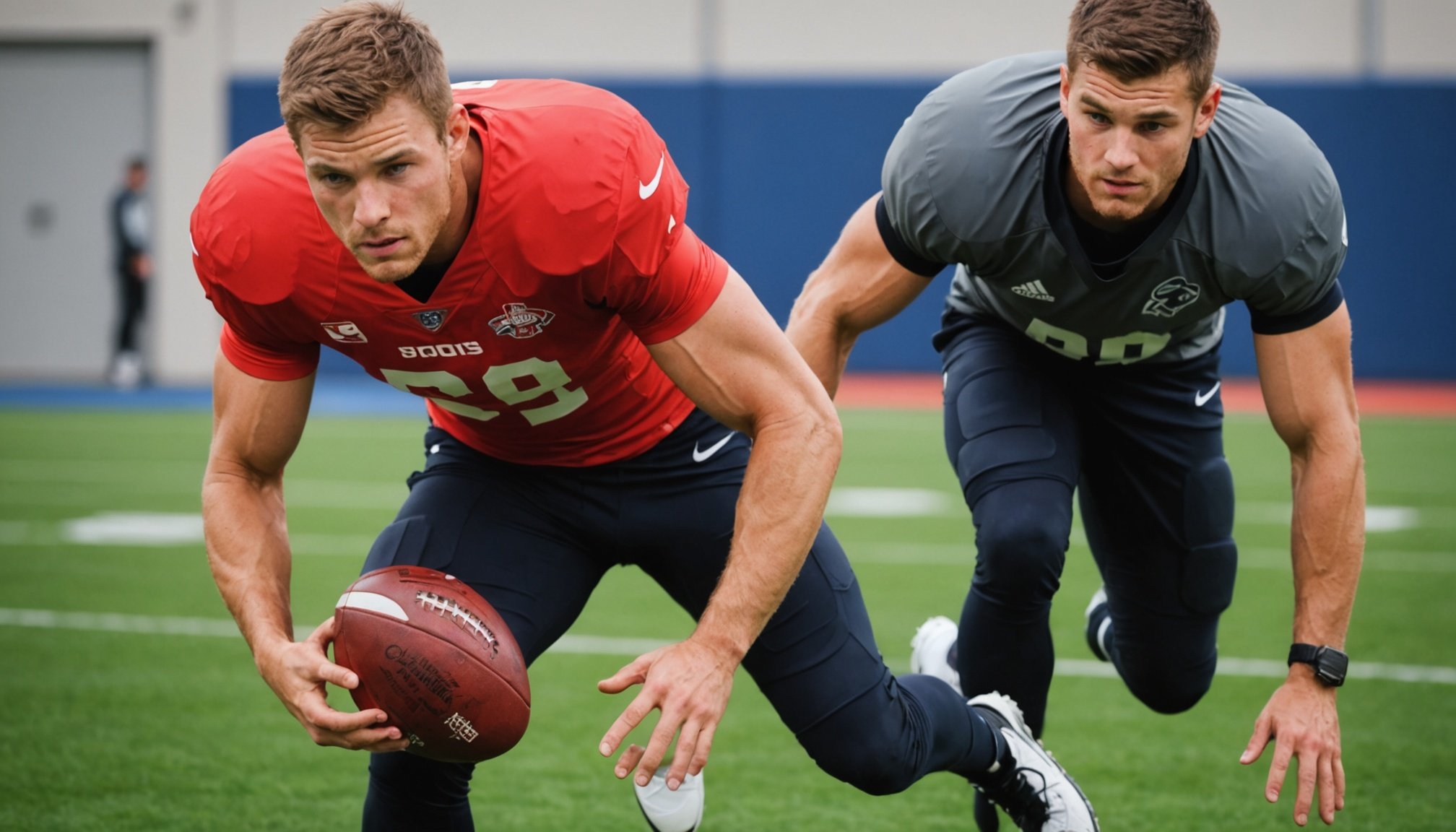Top Cooling Down Techniques for Football Players: Maximize Recovery Post-Training!
Why Cooling Down is Crucial for Football Players
Cooling down after a intense football training or game is often overlooked, but it is a critical component of the recovery process. When you engage in high-intensity activities like football, your body undergoes significant stress, leading to increased heart rate, elevated blood pressure, and muscle fatigue. A proper cool-down helps in gradually reducing these physiological responses, thereby aiding in the recovery of your body.
“Without consistent cool-down routines, athletes can experience prolonged muscle soreness and reduced performance in subsequent training sessions or games,” notes Misty Seidenburg, a physical therapist specializing in sports injuries.
This might interest you : Winning Strategies: Top Tactical Changes for Football Teams in Challenging Wet Weather
Effective Cool-Down Techniques
Low-Intensity Cardiovascular Exercise
One of the most effective ways to cool down is through low-intensity cardiovascular exercises. This can include jogging, walking, or cycling at a gentle pace. These activities help in gradually reducing your heart rate and blood pressure, improving blood flow, and aiding in the removal of metabolic waste products from your muscles.
“For example, a 5-10 minute jog or walk after a game can significantly reduce muscle soreness and improve overall recovery,” advises a fitness expert from Pendle Sportswear.
In the same genre : Effective Strategies to Minimize ACL Injury Risks in Football: Proven Techniques Revealed
Static Stretching
Static stretching is another essential cool-down technique. Unlike dynamic stretches that are used during warm-ups, static stretches involve holding a stretch for several seconds to improve flexibility and range of motion.
“Static stretches after activity improve circulation, flexibility, and range of motion, which are all crucial for injury prevention and recovery,” explains a health expert from Bupa UK.
Here are some key static stretches to include in your cool-down routine:
- Hamstring Stretch: Stand with your feet shoulder-width apart, then bend forward at the hips to reach for your toes.
- Quad Stretch: Stand with one hand against a wall for balance, lift one leg behind you, and hold the stretch.
- Calf Stretch: Stand facing a wall with one hand on the wall for balance, step one foot back about a foot and a half, and bend the front knee.
- Hip Flexor Stretch: Kneel on all fours, bring one knee forward, and place your foot flat on the ground in front of the other knee.
Advanced Cooling Down Methods
Foam Rolling and Self-Myofascial Release
Foam rolling is a form of self-myofascial release that helps in reducing muscle tension and improving blood flow. By rolling out your muscles, you can break down adhesions and scar tissue, which can help in reducing muscle soreness.
“Foam rolling after a workout can significantly reduce muscle soreness and improve recovery by enhancing blood flow and reducing muscle damage,” suggests Alonzo Wilson, founder of Tone House.
Here’s how you can incorporate foam rolling into your cool-down routine:
- Focus on Key Areas: Pay special attention to areas like your hamstrings, quadriceps, calves, and hip flexors.
- Use Proper Technique: Roll slowly over the muscle, applying moderate pressure. When you find a tender spot, hold the foam roller there for a few seconds before continuing.
Cold Water Immersion and Ice Baths
Cold water immersion (CWI) and ice baths are popular recovery techniques among athletes. These methods involve immersing your body in cold water to reduce inflammation and muscle soreness.
“Cold water immersion can be an effective way to speed up recovery by reducing muscle inflammation and improving blood flow,” notes a sports medicine expert.
Here are some tips for using CWI and ice baths effectively:
- Temperature: The water should be between 10°C and 15°C.
- Duration: Stay in the cold water for 10-15 minutes.
- Frequency: Use CWI or ice baths within 30-60 minutes after intense exercise.
Practical Insights and Actionable Advice
Hydration and Nutrition
Proper hydration and nutrition are crucial for recovery. Here are some tips to help you maximize your recovery through what you drink and eat:
- Stay Hydrated: Drink plenty of water post-workout to replenish lost fluids. Aim for at least 8-10 glasses of water per day.
- Eat the Right Foods: Focus on consuming a balanced diet rich in proteins, carbohydrates, and healthy fats. Foods high in antioxidants like berries, nuts, and leafy greens can also help in reducing muscle damage.
“Staying hydrated and eating the right foods can significantly enhance your recovery process by providing your body with the necessary nutrients to repair and rebuild muscle tissue,” advises a nutritionist.
Sleep and Rest
Adequate sleep and rest are essential for muscle recovery. Here’s why:
- Muscle Repair: During sleep, your body repairs and rebuilds muscle tissue.
- Performance: Lack of sleep can negatively impact your performance in subsequent training sessions or games.
“Getting enough rest and sleep is critical for athletes. It allows the body to recover from the physical stress of training and games, thereby improving overall performance,” explains Misty Seidenburg.
Table: Comparing Different Cool-Down Techniques
| Technique | Description | Benefits | Duration |
|---|---|---|---|
| Low-Intensity Cardio | Jogging, walking, or cycling at a gentle pace | Reduces heart rate, improves blood flow, aids in removing metabolic waste | 5-10 minutes |
| Static Stretching | Holding stretches for several seconds | Improves flexibility, range of motion, reduces muscle soreness | 10-15 minutes |
| Foam Rolling | Self-myofascial release using a foam roller | Reduces muscle tension, improves blood flow, breaks down adhesions | 5-10 minutes |
| Cold Water Immersion | Immersing body in cold water | Reduces inflammation, improves blood flow, speeds up recovery | 10-15 minutes |
| Hydration and Nutrition | Drinking water and eating a balanced diet | Replenishes fluids, provides necessary nutrients for recovery | Ongoing |
| Sleep and Rest | Getting adequate sleep and rest | Repairs and rebuilds muscle tissue, improves performance | 7-9 hours per night |
Quotes and Anecdotes
- “Cooling down is not just about stretching; it’s about giving your body the time it needs to transition from a high-intensity state to a resting state,” says a physical therapist.
- “After a tough game, I always make sure to cool down properly. It makes a huge difference in how I feel the next day,” shares a professional football player.
- “Incorporating foam rolling into my cool-down routine has significantly reduced my muscle soreness and improved my overall recovery,” notes Alonzo Wilson.
Cooling down after a football training or game is a vital part of the recovery process. By incorporating low-intensity cardiovascular exercises, static stretching, foam rolling, and cold water immersion into your routine, you can significantly enhance your recovery, reduce muscle soreness, and improve your overall performance.
Remember, recovery is just as important as training. By taking the time to cool down properly, you are investing in your body’s ability to perform at its best in the long run.
So, the next time you step off the field, don’t rush to the locker room just yet. Take a few minutes to cool down, and watch how it transforms your game.











